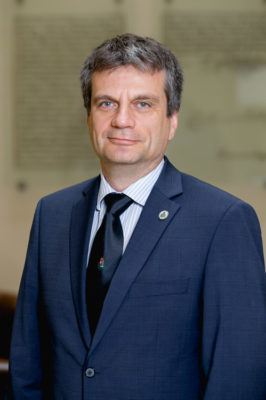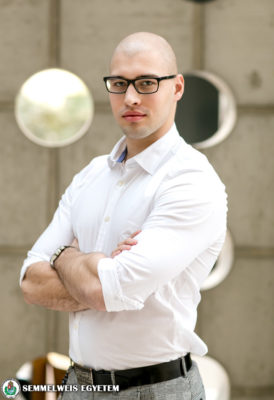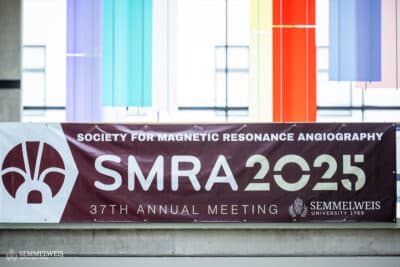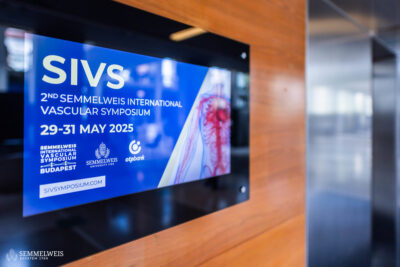The first joint conference focusing on health sciences and innovation organized by the Association of Hungarian PhD Students (DOSZ) and the Doctoral Students’ Union of Semmelweis University was held online on 29-30 January with the participation of about 150 people. The online event was opened by Dr. Péter Ferdinandy, Vice-Rector for Science and Innovation at Semmelweis University, the chief patron of the event. In his opening speech, he highlighted the practice of innovation, research and development as well as available opportunities offered via the university. The main prize for the Most Innovative Presentation was received and shared by PhD students of the Institute of Translational Medicine, Dr. Flóra Antali and Dr. Dániel Kulin.
 “Doctoral schools are the bastions of science and one of the main sources of supply of human resources for our lecturers, university professors and scientists, therefore we also pay special attention to this institution”, said Dr. Péter Ferdinandy, Vice-Rector for Science and Innovation at Semmelweis University on the occasion of opening the Health Sciences and Innovation Conference.
“Doctoral schools are the bastions of science and one of the main sources of supply of human resources for our lecturers, university professors and scientists, therefore we also pay special attention to this institution”, said Dr. Péter Ferdinandy, Vice-Rector for Science and Innovation at Semmelweis University on the occasion of opening the Health Sciences and Innovation Conference.
The conference was jointly organized by the Association of Hungarian PhD Students (DOSZ) and the Doctoral Students’ Union. The event, which is the first such conference organized by DOSZ, was hosted this year by Semmelweis University in the online space. According to the vice-rector, it is extremely important for the university to be an active participant in medical research and in the development of new innovative procedures and tools, both in Hungary and on an international level, too. As he said, the successful university of the future needs to be more practical, innovative and flexible, since knowledge in this field almost doubles every 2 years, with which one needs to keep up.
“The aim of Semmelweis University is to be a strong member of the Hungarian and regional innovation ecosystem, as part of which we support all kinds of multidisciplinary activities in the field of broader health sciences”, Dr. Péter Ferdinandy said.
 “The main goal of the conference is to provide as many PhD students as possible with the opportunity to present their research results and expand their own knowledge, despite the epidemic situation in the world”, said Dr. Szabolcs Bozsányi, President of the Medical and Health Science Section of the Association of Hungarian PhD Students, a PhD student at Semmelweis University. He recalled that the event focusing on innovation within the field of medicine and health sciences had been created as a “little brother” of the PhD Scientific Days.
“The main goal of the conference is to provide as many PhD students as possible with the opportunity to present their research results and expand their own knowledge, despite the epidemic situation in the world”, said Dr. Szabolcs Bozsányi, President of the Medical and Health Science Section of the Association of Hungarian PhD Students, a PhD student at Semmelweis University. He recalled that the event focusing on innovation within the field of medicine and health sciences had been created as a “little brother” of the PhD Scientific Days.
“We would like to create a tradition with the conference and to present the role of innovation in other disciplines in order to facilitate the transfer of knowledge between scientists and researchers in different fields”, emphasized Dr. Szabolcs Bozsányi.
He also briefly introduced DOSZ: the association was founded in 1994, with 20 scientific sections and more than 500 members. As he pointed out, the Doctoral Students’ Union of Semmelweis University maintains a close relationship with DOSZ, they organize events together, they support each other’s work.
In the opening speech of the conference, Dr. Péter Ferdinandy, Vice-Rector for Science and Innovation, Head of the Department of Pharmacology and Pharmacotherapy highlighted the practice of innovation, research and development as well as the available opportunities offered via the university. He presented the role and development of innovation in drug development, emphasizing that innovations today are practically limited only by imagination. He pointed out that developing a new drug is a long and extremely costly process that can take up to 8-15 years and consume up to 1-2 billion USA dollars, yet each year, the number of approved new, innovative drugs is steadily increasing. Addressing doctoral students, Dr. Ferdinandy said that they may participate in such innovation activities in a number of ways, whether working for large global pharmaceutical companies or small and medium-sized biotechnology companies, or, of course, as a university researcher. He pointed out that Hungary, and within this, Semmelweis University, has excellent knowledge and opportunities in this field, and although it is doing well in terms of publications, yet further improvements are needed as regards the number of patents.
“The planned Science Park investment aims to strengthen the university’s innovation activities, with the aim of operating about 100 incubation and spinoff companies in the field of health science and biotechnology within the scope of Semmelweis University”, Dr. Péter Ferdinandy said.
 The event, together with the lecturers and registered participants, was attended by a total of about 150 people from the four medical universities in Hungary, as well as from Japan and Sweden. In addition to presenting the scientific works of doctoral students, the program included roundtable discussions, workshops and plenary sessions with world-renowned researchers and lecturers. In the summary of Dr. Szabolcs Bozsányi, he highlighted the presentations by Dr. János Szlávik, Chief Infectologist of the South Pest Central Hospital and the presentation about the 3D printer laboratory of Semmelweis University (Dr. Dániel Végh, Dr. Imre Barabás and Dr. Dániel Palkovics). In addition to these, the following presentations were also highlighted: by Prof. Johan Malm and Prof. György Marko-Varga from Lund University, Sweden and by Prof. Takamitsu Fujimaki from Saitama Medical University, Japan, as well as and the roundtable discussion on social media with Mariann Forgács and Dr. András Kulja.
The event, together with the lecturers and registered participants, was attended by a total of about 150 people from the four medical universities in Hungary, as well as from Japan and Sweden. In addition to presenting the scientific works of doctoral students, the program included roundtable discussions, workshops and plenary sessions with world-renowned researchers and lecturers. In the summary of Dr. Szabolcs Bozsányi, he highlighted the presentations by Dr. János Szlávik, Chief Infectologist of the South Pest Central Hospital and the presentation about the 3D printer laboratory of Semmelweis University (Dr. Dániel Végh, Dr. Imre Barabás and Dr. Dániel Palkovics). In addition to these, the following presentations were also highlighted: by Prof. Johan Malm and Prof. György Marko-Varga from Lund University, Sweden and by Prof. Takamitsu Fujimaki from Saitama Medical University, Japan, as well as and the roundtable discussion on social media with Mariann Forgács and Dr. András Kulja.
Based on the abstracts introduced at the event, the main prize for the Most Innovative Presentation and the accompanying Semmelweis University 250 commemorative medal were received and shared by Dr. Flóra Antali and Dr. Dániel Kulin, both of whom are PhD students at the Institute of Translational Medicine at Semmelweis University. Finally, Dr. Szabolcs Bozsányi thanked the members of DOSZ and the organizing team of the Doctoral Students’ Union of Semmelweis University (Dr. Sándor Erdős, Dr. Letícia Szadai, Dr. Antal Jobbágy, Dr. András Szilágyi, Dr. Áron Bartha, Dr. Dániel Imre Szőke, Dr. Bálint Madarász, Vivien Telek, Dr. Ákos Bérczi, Dr. Jason Sparks and Gellért Raffai) for their work.
Tamás Deme
Photo: Attila Kovács – Semmelweis University (featured image: illustration, archive portrait photos)
Translation: Katalin Illés-Romhányi


